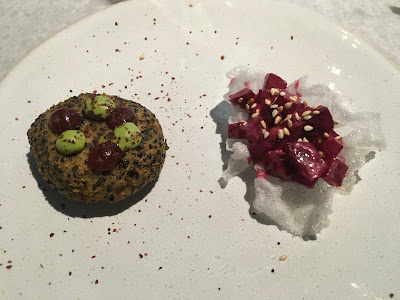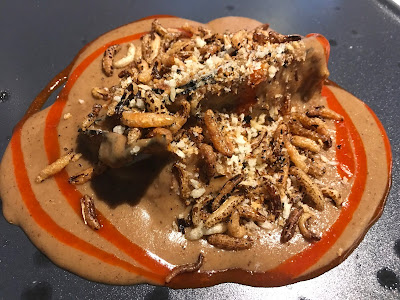Veganism is a problem for a gourmand, an epicurean, an old bloke who likes good food. I am a product of the 1950s and 60s when meat was celebrated by my parents’ generation simply because it was easily available again after the years of restricted availability inflicted by the necessary rationing of World War 2 and the unnecessary extended rationing of Attlee’s socialist government. Of course meat was not cheap and remained a luxury but at least it was a luxury that was obtainable even if the housewives of the day generally thought it would kill you if it were not near cremated in the cooking. The offspring of those who had endured 13 years of war and the ensuing intense socialism were therefore fed meat not infrequently, if only to give their parents a sense of liberation from the dual horrors of World War and a Labour government. Churchill was back in power and his return had brought the British a sense of freedom to enjoy yourself again even if only modestly. Meat - good quality British meat - was back on the menu.
Naturally my generation grew rather attached to eating meat. We rarely had chicken - it was too expensive to eat more than occasionally and the main occasion for having a really good meat indulgence was naturally Sunday lunch when housewives pushed the boat out to delight their families with Sunday roast - beef with Yorkshire pudding, pork with stuffing and apple sauce and lamb with mint sauce. It’s hardly surprising therefore that old blokes like a bit of meat with their meal. Of course fish is perfectly satisfactory and even something with cheese might just do but a main course with a carrot as the centre piece is, er, difficult to swallow.
The 60s ended and Elizabeth David and her Italian (and French) cuisine became all the rage and even though the quality of the ingredients available to the continentals was much poorer than the quality British products, the British enthused about the cuisines David was promoting because they still centred on meat in the main. But the era of post-war socialist austerity was over and the British became increasingly free to experiment with all sorts of non-mainstream dishes. Young people were allowed to speak up more and little girls did not like to think of animals being killed for humans to eat them and so they told their mothers they would not eat meat and vegetarianism lodged itself into the British culinary environment.
As Britain waded through the 80s with its nouvelle cuisine, Beaujolais Noveau and burgeoning numbers of celebrity chefs, vegetarianism dug its nails into British gastronomy and would not let go. The rise of easily obtainable south Asian and Chinese-style food was mainly based on meat and poultry dishes even though a major religion of South Asia embraced vegetarianism. Indeed Gandhi on his visit to Britain in 1931 visited the restaurant at The Pitman Vegetarian Hotel in Corporation Street and that reminds us that vegetarianism is hardly a modern fad - the hotel dates back to 1898 and was run by James Henry Cook and was named after Sir Isaac Pitman who was the Vice President of the Vegetarian Society and was in business until the 1930s.
As Modern British cuisine started to displace French, Italian, South Asian and Chinese food, the trendy food style, vegetarianism, begin to evolve into what was first seen as cranky full-blown veganism. All over the land it seemed that young girls were refusing to eat anything that would normally be seen walking about. And the trend spread to adults, doubtless more to women than men who generally, unless their religion forbade it, (or sometimes, even if it did) could not embrace life without an occasional bacon sandwich. Eventually the weight of numbers elevated veganism to an important aspect of British food and notable chefs, or some of them at least, began to take notice of it and then embraced it fully. Which is where we are today.
To be honest I too have regrets thinking about an animal, a sentient being now according to The Law, being killed so that I can indulge my appetite. So the question is, could I be a vegan and ease my conscience whilst eating my lunch? Is vegan food really tolerable to we who experienced the postwar meat liberation years? and what would I be missing as an ex-omnivore?
At least one review of Land (Jay Rayner, The Guardian) had waxed lyrical about this restaurant opened by chef Adrian Luck in 2019 in the atmospheric, rather gorgeous,Victorian Great Western Arcade and it had been a well thought of restaurant up until the pandemic but had not reopened after the recent wave until about 3 weeks ago. Rayner’s review had mused how chefs in general had failed through various phases to address the vegetarian option let alone the vegan question. He highlighted how, just as mainstream gastronomy in England had had its phases and fashions - from the end of rationing to the present Japanese-style/Baltic-Scandinavian/Foraged trends, so too, he reflected almost with bemusement, the fashions of British vegetarianism in the last forty years - from nut cutlet (I had one once in 1981 in a vegetarian restaurant in Edgbaston I think and recall deriving a degree of pleasure from eating it) to roast cauliflower (not yet an extinct species) which he called “the cauliflower years”, then “the aubergine years” and the all-enveloping entity of the wild mushroom risotto. How very true. And even if we haven’t ordered this stuff from a mainstream menu’s vegetarian option (and to be honest, like Rayner who wrote, “Love a bit of roasted cauliflower me”, I have indeed ordered it when everything else on the menu was unappealing) we all recognise the truth that most chefs are going through the motions when they even bother to offer a vegetarian option.
But Land is an earnestly honest, devoted, impressive vegan restaurant which casts all thoughts of another charred slice of cauliflower into the pit of my fading memories. The restaurant is small, smart and perhaps a little dark inside, an effect partially of the apt but ardent dark green wallpaper on one side of it. The menu was typed on to an uncompromisingly small scrap of paper; no room to complain about wastage even as far as the amount of paper used for menus is concerned. In the open kitchen Adrian Luck could be seen performing his culinary art like any of the other notable Birmingham chefs who allow the dining public to peep in on their activities while they are preparing each course.
At the top of this piece is a photograph of two delicious little appetisers, one of them a tasty little chopped beetroot item. Then the bread, golden yellow cornbread, light, pleasingly moist like a little fairy cake and with a flavour that told my dining companion and I that we were on new territory some distance from our usual haunts. What a relief not to have yet more sourdough.
I’m really not sure what you call the first non-bread course of an all vegetable meal. Where meat reigns supreme it would be the starter but here let’s call it the First course, though you might say it is the third course (it’s like the English King Edwards [not the potatoes] - there were eight of them but actually there were three King Edwards before King Edward I, if you get my drift). The First course then was not the most elegant-looking dish - nicely cooked cannellini beans in a ‘creamy sauce’ with onion and texture from samphire but burdened, we thought, with an uncompromising, aggressive seaweed tapenade. True, the beans needed something additional but the seaweed did not give us too much pleasure.
We were both lifted to a state of immense satisfaction by the Second course, perfectly cooked carrot with zough (a Yemeni dressing pronounced Zug) and an elegant, lattice tuile. What a delightful dish.
Then a dish of puréed kohlrabi, which could have been substituted by a pomme purée but it’s good to have something a little different, with beech mushrooms providing texture and swirls of herby cream and a miso soup. I grew a little tired as I worked my way through the sizeable dish but appreciated the flavour. Then a spectacular-looking dish of sweet charred hispi cabbage with a satay sauce, a flash of chilli and crunchy puffed rice. And then on to two desserts.
The first dessert was just up my street, or perhaps in this restaurant’s case it would be more apt to say “just up my country lane”, being exquisitely tart marinated cherries on a crunchy bed of oats with a subtle but deliciously oat flavoured ice cream and a cherry sorbet. A dessert I would happily eat every day. Then an elongated finger like chocolate brownie which was probably my least favourite course, not helped admittedly by general lack of enthusiasm for chocolate desserts, but also due to the vaguely unpleasant texture which I found to be mildly craggy.
But no matter, on balance an exciting, original and tasty meal precisely and devotedly put together. We both, and I’m sorry about this, fantasised about having a little well-cooked pork belly with the kohlrabi dish or some chicken with the satay, so hard it is for our generation to evict meat from our desires. But this is a restaurant that’s heading for local fame and probably national recognition and such acknowledgments will be well deserved. But after all this, and of course, barring a sudden miraculous Damascene conversion, changing an old bloke’s mindset about the need to have meat or fish was never going to happen in a pleasant two to three hour-long lunch experience. My dining companion both came away feeling that we had dined very well but we had not dined completely. Meat does add something final to a meal, a substantiality, and it may be hard for the most brilliant vegan food chef to fill that gap.











No comments:
Post a Comment